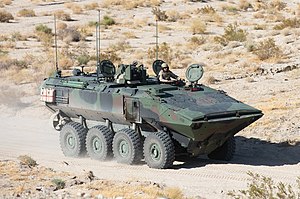| Amphibious Combat Vehicle (ACV) | |
|---|---|
 An Amphibious Combat Vehicle assigned to the US 3rd Assault Amphibian Battalion in 2021 | |
| Type | Amphibious assault vehicle |
| Place of origin | United States, Italy |
| Service history | |
| Used by | United States Marine Corps |
| Production history | |
| Designer | based on Iveco SuperAV |
| Manufacturer | Iveco and BAE Systems |
| Developed from | Iveco SuperAV |
| Unit cost | |
| Produced | Since 2018 |
| Variants | ACV-P (APC), ACV-C (C2), ACV-R (ARV), ACV-30 (IFV) |
| Specifications ([4]) | |
| Mass | 32 t (71,000 lb) |
| Length | 361 in (9.2 m) |
| Width | 124 in (3.1 m) |
| Height | 114 in (2.9 m) (hull) |
| Crew | 3[3] |
| Passengers | 13[3] |
Main armament | M2 Browning with Remote controlled weapon station (RCWS), for first 36 pilot units |
Secondary armament | (as a replacement) OTO Melara Hitfist OWS or Leonardo Hitrole |
| Engine | Iveco Cursor 16 700 hp (520 kW) 3,000 N⋅m (2,200 ft⋅lb) |
| Power/weight | 21.56 hp/t (16.08 kW/t) |
| Payload capacity | 3.3 t (7,300 lb) |
| Transmission | Allison 4800SP (automatic, 7 forward, 2 reverse) |
Operational range |
|
| Maximum speed | 65 mph (105 km/h) (paved road) 6 kn (11 km/h) (water) |
The Amphibious Combat Vehicle (ACV) is a program initiated by Marine Corps Systems Command to procure an amphibious assault vehicle for the United States Marine Corps to supplement and ultimately replace the aging Assault Amphibious Vehicle (AAV). The program replaces the Expeditionary Fighting Vehicle (EFV) program canceled in 2011. Originally a plan to develop a high-water-speed vehicle, the program has expanded into a multi-phased approach to procure and develop several types of amphibious-capable vehicles to address near and long-term requirements.
The competition for the project ended in 2018 with the birth of an eight-wheel drive armoured fighting vehicle, based on the Italian Iveco SuperAV. Production by BAE Systems and Iveco started in 2020 with 36 units, and 80 vehicles per year from 2021, for five years.[5][6][7][8][9]
- ^ McNeil, Harry (2023-12-11). "US Marine Corps boosts amphibious power with $211m order". Naval Technology. Retrieved 2024-04-29.
- ^ "BAE Systems receives $256 million full-rate production contract from U.S. Marine Corps for additional Amphibious Combat Vehicles". www.baesystems.com. 6 March 2023. Retrieved 2024-01-31.
- ^ a b Amphibious Combat Vehicle (ACV) Family of Vehicles, Director Operational Test and Evaluation, retrieved 1 October 2024
- ^ "Amphibious Combat Vehicle". Military. Retrieved 2024-11-06.
- ^ "Marines Pick BAE to Build Amphibious Combat Vehicle; Contract Worth Up to $1.2B". USNI News, 19 June 2018.
- ^ "BAE Systems delivers first ACV Amphibious Combat Vehicles to U.S Marine Corps". Army Recognition, 21 October 2020.
- ^ "Marine Corps receives first amphibious combat vehicle". Marine Corps Times, 10 November 2020.
- ^ "New Amphibious Combat Vehicle ACV officially introduced to US Marine Corps". Army Recognition, 8 November 2020.
- ^ "Marine Corps’ amphibious combat vehicle reaches full-rate production". Defense News, 12 December 2020.